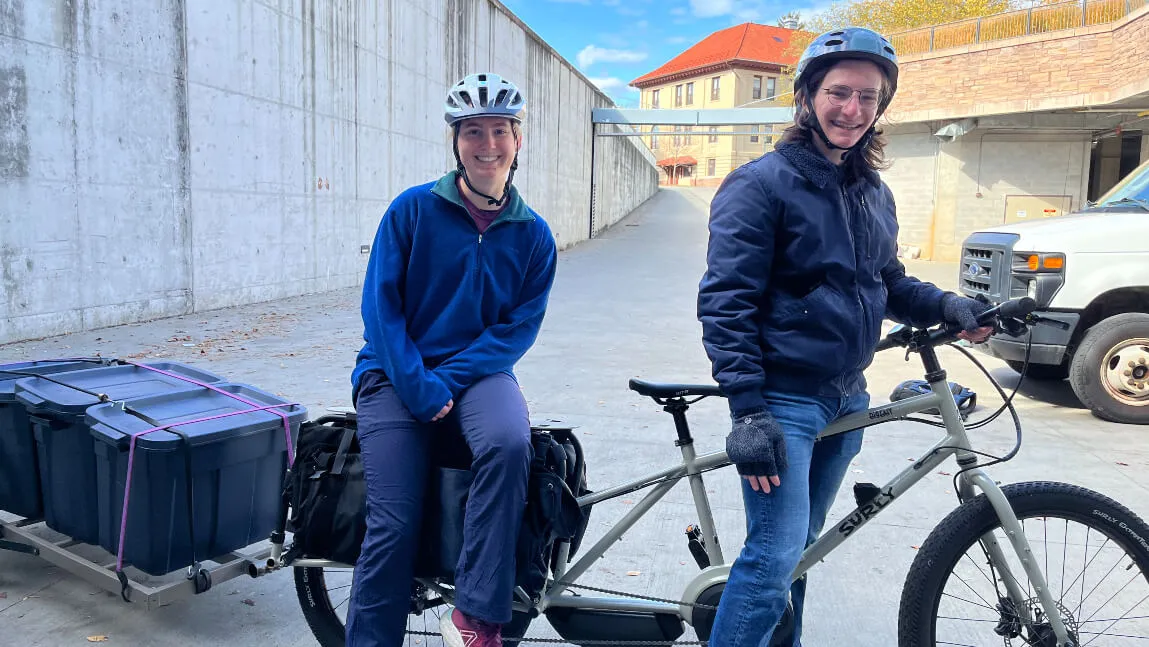This fall, the residential hall composting program underwent a major expansion after a two-year pilot proved that more convenient collection points significantly increased student participation.
“Diverting food scraps and compostable material from the landfill is a practice our students have consistently embraced when given the opportunity,” said Corey Berman, UVM’s Recycling and Zero Waste Program Coordinator, who led the pilot program. “It felt like the time to make composting as accessible as recycling in the residence halls.”
UVM dining areas have been collecting food waste since 1997. But these days, students are increasingly choosing to eat meals at times convenient for their busy schedules. The growth of take-out dining on campus means more organic waste can accumulate in residence halls. Until this fall, students brought their food scraps to collection bins located in the lobby of each residence hall using small food waste bags provided at the front desks of their building.
A team of student Eco-Reps pedal across campus using an electric cargo bike equipped with a trailer. They empty the bins three times per week, hauling everything they collect to a climate-controlled cooler in the Davis Center. That material is then transported to Green Mountain Compost in Williston, which turns it into high quality compost that’s available at many local garden stores.
Over the past two years, Mercy, McAuley and Marsh-Austin-Tupper residence halls were chosen to test whether providing compost collection bins on each floor would increase composting. These buildings saw an average 76% increase in participation in the first year of the pilot and composting rates continued to be significantly higher in these buildings than other halls in the second year.
Weighty matter
The UVM Comprehensive Sustainability Plan set a goal to reduce overall waste by 10% while simultaneously increasing composting and recycling by 10%. Berman won a Sustainable Campus Fund award to commission a campus waste characterization study, a robust audit of campus trash and recycling, to help inform new policies and programs and guide UVM’s zero waste priorities.
The study was completed in 2025 and estimates that if all compostables and recyclables on campus were sorted into the correct bins, UVM could reduce 604 metric tons of carbon dioxide equivalent.
Residence halls generate almost half of overall waste on campus, much more waste than other types of buildings. According to the study, food scraps and paper napkins make up roughly 35% of what is put into the trash cans in residence halls, by weight.
“The results of our pilot and the waste characterization study confirm there are big opportunities if we can expand collection, and residence halls are the obvious place to start,” said Berman. One hurdle was ramping up the collection process.
Key campus partners step in
While Eco-Reps students could continue emptying the lobby level bins, staff support would be needed to consolidate the material from the upper floors. Berman approached the necessary partners, who jumped on board with the plan.
“We’re happy to collaborate to make sure the living environment is clean and comfortable for students while helping UVM achieve its sustainability goals,” said Charles Holmes-Hope, Executive Director of University Housing and Dining Services.
Custodial staff already visit the residence halls waste rooms daily to remove trash and recyclables. “Collecting food waste is another way we can demonstrate our commitment to sustainability on campus,” noted Gerald Coleman, Custodial Services Director.
“We couldn’t have launched this effort without the support of our partners,” said Caylin McCamp, Office of Sustainability Interim Director. “I think it is a great example of how departments across campus are willing to help make UVM’s operations more sustainable.”
With these critical pieces in place, Berman coordinated a summer roll out of new bins and signage across the halls and Eco-Reps are conducting ongoing education and outreach now that the academic year is in full swing. Initial results show an increase of 63% in student participation with almost 1.5 tons of organics collected over the first six weeks of the semester. More detail will be available in the CSP annual report released this spring.

